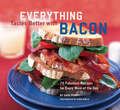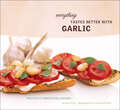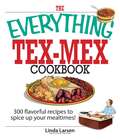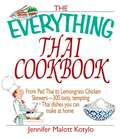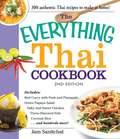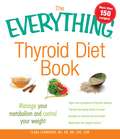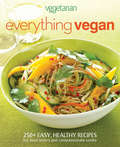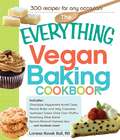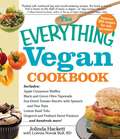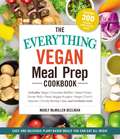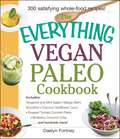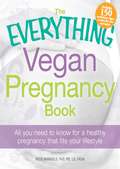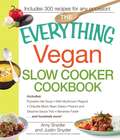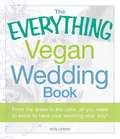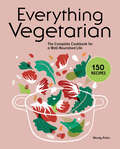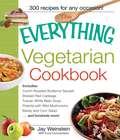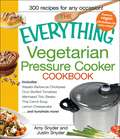- Table View
- List View
Everything Tastes Better with Bacon: 70 Fabulous Recipes for Every Meal of the Day
by Sara PerrySeventy recipes that let you savor the flavor of bacon any time of day, plus bacon lore, bacon tips, and resources for finding great bacons.From classic breakfast treats like Daddy’s Fluffy Scrambled Eggs with Bacon to elegant main courses of Linguine and Bacon with Vodka Sauce, each savory dish is better than the last. Even desserts are improved with a few bits of this tasty treat. Double-Crunch Peanut Butter Cookies will keep everyone guessing about the secret ingredient!Discover intriguing bacon lore and other practical tips, from the origin of the phrase “bringing home the bacon” to some surprising nutritional facts (seems those tasty little strips aren’t so bad for the hips after all). No matter how you slice it, Everything Tastes Better with Bacon.
Everything Tastes Better with Garlic: Positively Irresistible Recipes
by Sara PerryExplore the power of garlic in every course with this zesty collection of recipes from the author of Everything Tastes Better with Bacon.The marvelous aroma and mouthwatering flavors of garlic are waiting to be discovered. Author Sara Perry’s rendition of treasured favorites like Caesar salad, chicken with forty cloves (and counting), old-fashioned garlic bread, and mesmerizing mashed potatoes are all here, along with sassy newcomers such as Grilled T-Bone Steaks with Garlic Bourbon Barbecue Sauce, Garlic Risotto with Baby Peas and Truffle Oil, Six Cloves Mac and Cheese, Coney Island Hot Dogs with Damn-Good Garlic Sauce, and quick-as-you-please Crispy Garlic Potato Chips.In addition to the delicious, you’ll also find handy lists featuring all things garlic, including books and informative websites, garlic farms and garden sources, and a year-round calendar of garlic festivals to help you explore garlic in its many guises.No matter how you chop, mince, grate, press, sauté, roast, or cook it, everything tastes better with garlic.“This is a charming volume from which to pick and choose.” —Publishers Weekly
The Everything Tex-Mex Cookbook: 300 Flavorful Recipes to Spice Up Your Mealtimes! (Everything® Series)
by Linda LarsenAn American tradition since the 1800s, Tex-Mex food combines the flavors of a wide variety of ingredients with the influence of different cultures to create unique dishes that are crafted to perfection.Tomatoes, beef, beans, chiles, and corn are the staples of Tex-Mex cooking, while flavor, texture, and personality are added with specialties such as hot sauce, chorizo, and spices such as chili pepper and cayenne pepper. Packed with 300 not-quite-south-of-the-border recipes, The Everything Tex-Mex Cookbook brings these authentic flavors to your very own kitchen. Features recipes for: -Chilled Avocado Soup -Red Snapper Flautas -Oven Barbecued Beef Brisket -Chicken Chimichangas -Mixed Bean Lasagna -Red Sangria -Peach Daiquiri Pie Whether you&’re looking for a quick party appetizer, dinner for your family, or drinks and dessert, The Everything Tex-Mex Cookbook has everything you need to add some color and spice to your daily menus!
The Everything Thai Cookbook
by Jennifer Malott KotyloThai cuisine creates a harmonious blend between spicy hot and comparatively bland ingredients from age-old Eastern and relatively new Western foods. Featuring both outstanding traditional recipes and cutting-edge crowd-pleasers such as Spicy Fried Rice Sticks, Salmon Toast, Chicken Satay, and Thai Crab Cakes, The Everything Thai Cookbook guides you through preparing meals as good as you'd find in your favorite Thai restaurant.The Everything Thai Cookbook is perfect for both vegetarians and meat-eaters, offering an eclectic range of spices, flavors, and aromas.Whether you want to prepare a meal for one, or an entire feast, The Everything Thai Cookbook will have you serving up tasty fare to tempt even the most critical food connoisseur.
The Everything Thai Cookbook: From Pad Thai to Lemongrass Chicken Skewers--300 Tasty, Tempting Thai Dishes You Can Make at Home
by Jennifer Malott KotyloThai cuisine creates a harmonious blend between spicy hot and comparatively bland ingredients from age-old Eastern and relatively new Western foods. Featuring both outstanding traditional recipes and cutting-edge crowd-pleasers such as Spicy Fried Rice Sticks, Salmon Toast, Chicken Satay, and Thai Crab Cakes, The Everything Thai Cookbook guides you through preparing meals as good as you'd find in your favorite Thai restaurant.The Everything Thai Cookbook is perfect for both vegetarians and meat-eaters, offering an eclectic range of spices, flavors, and aromas.Whether you want to prepare a meal for one, or an entire feast, The Everything Thai Cookbook will have you serving up tasty fare to tempt even the most critical food connoisseur.
The Everything Thai Cookbook
by Jam SanitchatA modern, fresh take on Thai cooking! Do you love the taste of Thai food? Wish you could bypass the restaurant and prepare the same delicious food at home? With The Everything Thai Cookbook, 2nd Edition, you can master your favorite Thai dishes right in your own kitchen. This updated edition shows you how to make traditional Thai-American recipes, authentic Thai dishes, and fresh, new takes on Thai ingredients and flavors, including: Glass noodle salad Chicken satay sandwiches Jungle curry Salt-cured eggs Curried mussels Mango sticky rice Vegetarian? No problem! You'll find hundreds of meat-free recipes, and many more that can be adapted for either vegetarians or meat-eaters. No matter what your favorite Thai dish might be, you can learn to cook it at home with whole-food, natural ingredients.
The Everything Thai Cookbook: Includes Red Curry with Pork and Pineapple, Green Papaya Salad, Salty and Sweet Chicken, Three-Flavored Fish, Coconut Rice, and hundreds more!
by Jam SanitchatA Simon & Schuster eBook. Simon & Schuster has a great book for every reader.
The Everything Thai Cookbook
by Jam SanitchatA modern, fresh take on Thai cooking! Do you love the taste of Thai food? Wish you could bypass the restaurant and prepare the same delicious food at home? With The Everything Thai Cookbook, 2nd Edition, you can master your favorite Thai dishes right in your own kitchen. This updated edition shows you how to make traditional Thai-American recipes, authentic Thai dishes, and fresh, new takes on Thai ingredients and flavors, including: Glass noodle salad Chicken satay sandwiches Jungle curry Salt-cured eggs Curried mussels Mango sticky rice Vegetarian? No problem! You'll find hundreds of meat-free recipes, and many more that can be adapted for either vegetarians or meat-eaters. No matter what your favorite Thai dish might be, you can learn to cook it at home with whole-food, natural ingredients.
The Everything Thyroid Diet Book: Manage Your Metabolism and Control Your Weight (Everything® Series)
by Clara SchneiderThyroid problems, affecting an estimated 25 million people, can wreak havoc on your metabolism and overall health. With this diet book, you will find more than 100 recipes that are specifically designed to help you manage your condition and weight. This guide includes:An overview of how metabolism affects your bodyFoods to eat frequently . . . and foods to avoid at all costs100-plus recipes to aid specific thyroid problems--and help you stay healthyLifestyle changes and techniques that complement the recipesWith recipes so good it's a wonder they're healthy, this is the ultimate resource to learn how to eat right and successfully manage your thyroid condition!
Everything Vegan: 250+ Easy, Healthy Recipes for Food Lovers and Compassionate Cooks (Vegetarian Times)
by Vegetarian TimesA diverse and delicious collection of over 250 vegan recipes from the experts at Vegetarian Times magazine. Whether you&’re vegan for a day, a week, a lifetime, or even just for lunch hour, you&’re always on the lookout for deliciously satisfying animal-free recipes. Vegetarian Times Everything Vegan is the something-for-everyone vegan cookbook with hundreds of tasty, healthful recipes that can woo even omnivores to the possibilities of plant-based eating while wowing committed vegans and vegetarians. Beautifully illustrated and accompanied by a thoughtful and informative foreword by Neal D. Barnard, MD, Vegetarian Times Everything Vegan is a must-have resource for anyone who lives vegan, loves cooking, or is looking for healthy meal ideas with proven weight-loss benefits. Inside, you'll find: • 250+ easy, healthful recipes with nutrition information • 50+ beautiful full-color photos • Features, tips, and sidebars that provide helpful hints on food shopping, prepping ingredients, and speeding up cooking times
The Everything Vegan Baking Cookbook
by Lorena Novak BullIf you follow a vegan lifestyle, your egg- and dairy-free diet doesn't have to stop you from enjoying the sweets you love. You just need innovative takes on classic recipes and the newest culinary trends. Now you can make your own delicious desserts with this cookbook! Featuring 300 irresistible recipes with complete nutritional information, you'll prepare everything from chocolate chip cookies to red velvet cupcakes, including:Whoopie Pies Whole-Wheat SourdoughStrawberry Crumble BarsOlive and Artichoke FougasseGerman Chocolate Chip CupcakesGluten-Free Apple CrispWhether you choose to be vegan for health, ethical, or earth-friendly reasons, you won't have to sacrifice the delectable foods you love. With fresh, easy-to-find recipes and step-by-step instructions, you'll feel like a kid in a vegan candy shop!
The Everything Vegan Baking Cookbook: Includes Chocolate-Peppermint Bundt Cake, Peanut Butter and Jelly Cupcakes, Southwest Green Chile Corn Muffins, Rosemary-Olive Bread, Apricot-Almond Oatmeal Bars, and hundreds more!
by Lorena Novak BullIf you follow a vegan lifestyle, your egg- and dairy-free diet doesn't have to stop you from enjoying the sweets you love. You just need innovative takes on classic recipes and the newest culinary trends. Now you can make your own delicious desserts with this cookbook! Featuring 300 irresistible recipes with complete nutritional information, you'll prepare everything from chocolate chip cookies to red velvet cupcakes, including:Whoopie Pies Whole-Wheat SourdoughStrawberry Crumble BarsOlive and Artichoke FougasseGerman Chocolate Chip CupcakesGluten-Free Apple CrispWhether you choose to be vegan for health, ethical, or earth-friendly reasons, you won't have to sacrifice the delectable foods you love. With fresh, easy-to-find recipes and step-by-step instructions, you'll feel like a kid in a vegan candy shop!
The Everything Vegan Baking Cookbook
by Lorena Novak BullHome-baked vegan treats-straight Prom your oven!
The Everything Vegan Cookbook
by Jolinda HackettVeganism is about more than just avoiding meat and dairy; it's about cooking and eating healthy food while being good to the planet. Luckily, being good to the planet can be delicious! The Everything Vegan Cookbook is filled with 300 recipes that you'll love, whether you're simply curious or a lifelong vegan, such as:Fat-Free Banana BreadCurried Pumpkin SoupSpicy Southern JambalayaMaple Cinnamon Breakfast QuinoaFoolproof Vegan FudgeSweetheart Raspberry Lemon CupcakesSinfully Delicious Vegan Ice CreamChocolate Mocha Ice CreamCooking for your family every day on wholesome vegan foods can be easy! From quick and easy recipes for hectic weeknights to indulgent breakfasts for lazy weekend mornings, you'll have the confidence you need to take on a healthy, meat- and dairy-free lifestyle.
The Everything Vegan Meal Prep Cookbook: Includes: * Vegan Chocolate Waffles * Sweet Potato Dinner Rolls * Pesto Veggie Burgers * Vegan Chick'n Taquitos* Chunky Monkey Cake ... and hundreds more!
by Marly McMillen BeelmanEnjoy the numerous benefits of meal prepping especially for the vegan diet with this helpful guide!The hardest part of starting any new diet is committing to it—the vegan diet is no exception. You have every intention to stick to a plant-based diet…but then you get home from a long day of work and the urge to just order a pizza overcomes you. This is where meal prepping helps! By making all of your meals ahead of time and having them easily accessible and ready to go, it’s easier to fight off the cravings and stick to your healthy new diet. It’s also a great strategy to save tons of time and money! The Everything Vegan Meal Prep Cookbook provides hundreds of vegan recipes that make it easy to commit to your new diet—from a quinoa burrito bowl to slow cooker tortilla soup to fruit-on-the-bottom overnight oats, there’s something for every meal of the day! With this book and just a little advanced planning each week, you’ll be able to make simple and delicious meals that will prevent cravings, help you lose weight and eat healthier, and save time and money!
The Everything Vegan Paleo Cookbook
by Daelyn FortneyThe best of both worlds!You might think that paleo and vegan diets are complete opposites. But that's not true! There are plenty of foods besides meat in the paleo diet. After all, our ancestors were hunters and gatherers, and they likely ate plant-based diets for much of the time. Both paleo and vegan diets focus on clean eating, and The Everything Vegan Paleo Cookbook provides readers with 300 deliciously clean recipes that focus on fresh vegetables and fruits, nuts, sprouts, and healthy fats, including:Two-Tomato SalsaAvocado-Watermelon SaladAlmond Joy SmoothieAcorn Squash Autumn BisqueVeggie Kebabs with Chimichurri SauceTropical Cashew Nut ButterPistachio-Pumpkin Trail MixPlum Blueberry Coconut CrumbleWith these full-flavored, whole-food recipes, you'll have hundreds of options for following both the paleo and vegan lifestyles.
The Everything Vegan Paleo Cookbook: Includes Tangerine and Mint Salad, Mango Berry Smoothie, Coconut Cauliflower Curry, Roasted Tomato Zucchini Pasta, Blueberry Coconut Crisp...and Hundreds More!
by Daelyn FortneyThe best of both worlds!You might think that paleo and vegan diets are complete opposites. But that's not true! There are plenty of foods besides meat in the paleo diet. After all, our ancestors were hunters and gatherers, and they likely ate plant-based diets for much of the time. Both paleo and vegan diets focus on clean eating, and The Everything Vegan Paleo Cookbook provides readers with 300 deliciously clean recipes that focus on fresh vegetables and fruits, nuts, sprouts, and healthy fats, including:Two-Tomato SalsaAvocado-Watermelon SaladAlmond Joy SmoothieAcorn Squash Autumn BisqueVeggie Kebabs with Chimichurri SauceTropical Cashew Nut ButterPistachio-Pumpkin Trail MixPlum Blueberry Coconut CrumbleWith these full-flavored, whole-food recipes, you’ll have hundreds of options for following both the paleo and vegan lifestyles.
The Everything Vegan Pregnancy Book: All you need to know for a healthy pregnancy that fits your lifestyle
by Reed MangelsDo I need more protein?Am I getting enough nutrients for the baby?How do I defend my decision to stay vegan?These questions and more are on the minds of vegan moms-to-be who want to maintain their lifestyle but still nurture a healthy baby. Well, you can breathe a sigh of relief because a vegan pregnancy is not only possible, it's also healthy and completely safe. With this helpful guide, you will learn about all aspects of vegan pregnancy from conception to bringing home baby, including:Which foods to eat (and avoid!) to get optimum nutrients for you and babyHow to deal with disapproval from family and friendsMethods to ensure a vegan-friendly hospital birthSetting up a vegan nursery for the babyPacked with information for both moms and dads, including 150 nutritious and healthy recipes for the whole family, this book is the ultimate resource for parents who want the best for their baby--without sacrificing the vegan life!
The Everything Vegan Slow Cooker Cookbook: Includes Pumpkin-Ale Soup, Wild Mushroom Ragout, Chipotle Bean Salad, Peanut and Sesame Sauce Tofu, Bananas Foster and hundreds more!
by Amy Snyder300 recipes featuring fresh, natural ingredientsThink slow cookers are just for stews and roasts? Not anymore! Millions of home cooks know that a slow cooker makes it easy to create delicious, satisfying, and diverse meals with a minimal amount of preparation and hands-on cooking time. Now, with The Everything Vegan Slow Cooker Cookbook, vegan cooks can take advantage of this time-saver as well.In this versatile cookbook, you'll find recipes for hundreds of meals without meat, dairy, eggs, and other animal byproducts, including favorites like:Creamy Broccoli SoupFajita ChiliSpanish PaellaGinger-Lime TofuMixed Berry Cobbler In addition, this cookbook features all-natural, wholesome ingredients, with few processed and packaged foods. Vegans and nonvegans alike will find everything they need to create healthy dishes for any special occasion or family meal-in no time at all!
The Everything Vegan Slow Cooker Cookbook
by Amy Snyder Justin Snyder300 recipes featuring fresh, natural ingredients Think slow cookers are just for stews and roasts? Not anymore! Millions of home cooks know that a slow cooker makes it easy to create delicious, satisfying, and diverse meals with a minimal amount of preparation and hands-on cooking time. Now, with The Everything Vegan Slow Cooker Cookbook, vegan cooks can take advantage of this time-saver as well. In this versatile cookbook, you'll find recipes for hundreds of meals without meat, dairy, eggs, and other animal byproducts, including favorites like: Creamy Broccoli Soup Fajita Chili Spanish Paella Ginger-Lime Tofu Mixed Berry Cobbler In addition, this cookbook features all-natural, wholesome ingredients, with few processed and packaged foods. Vegans and nonvegans alike will find everything they need to create healthy dishes for any special occasion or family meal-in no time at all!
The Everything Vegan Slow Cooker Cookbook
by Amy Snyder Justin Snyder300 recipes featuring fresh, natural ingredients Think slow cookers are just for stews and roasts? Not anymore! Millions of home cooks know that a slow cooker makes it easy to create delicious, satisfying, and diverse meals with a minimal amount of preparation and hands-on cooking time. Now, with The Everything Vegan Slow Cooker Cookbook, vegan cooks can take advantage of this time-saver as well. In this versatile cookbook, you'll find recipes for hundreds of meals without meat, dairy, eggs, and other animal byproducts, including favorites like: Creamy Broccoli Soup Fajita Chili Spanish Paella Ginger-Lime Tofu Mixed Berry Cobbler In addition, this cookbook features all-natural, wholesome ingredients, with few processed and packaged foods. Vegans and nonvegans alike will find everything they need to create healthy dishes for any special occasion or family meal-in no time at all!
The Everything Vegan Wedding Book: From the dress to the cake, all you need to know to have your wedding your way!
by Holly LefevrePlanning a wedding from scratch is tough, but planning a vegan wedding is even tougher! With the lifestyle affecting nearly every part of their lives, including what they eat, wear, and use, vegan brides-to-be are often torn between having a conventional wedding and sticking to their beliefs. "The Everything Vegan Wedding Book" provides the answers these brides need! It shows brides how to make their weddings earth-friendly, animal-friendly, and even guest-friendly! Featuring extensive information on how to make any vegan wedding a hit with even the most doubtful attendee, this is the ideal guide for the ethical bride!
Everything Vegetarian: The Complete Cookbook for a Well-Nourished Life
by Wendy PolisiThe ultimate vegetarian recipe collection, featuring creative dishes and a delicious approach to healthy living There's a lot to celebrate with vegetarian cooking: exciting flavors and textures, plus endless recipe possibilities that keep things interesting in the kitchen and at the dining table. Everything Vegetarian is the vegetarian cookbook that makes it easy to shop, prep, and cook 150 mouthwatering vegetarian meals that are loaded with great flavors and good nutritional value. Featuring dishes like Southwestern Egg Rolls and Mushroom Wellington, this vegetarian cookbook has something for everyone. The creative menus and wide variety of recipes allow for fun experimenting in the kitchen using plenty of nutritious and easy-to-find ingredients. You'll also discover simple tips that make cooking tasty meals easy and an extensive reference guide to prepping and cooking different fruits and vegetables. This extensive vegetarian cookbook includes: Wine guide—Discover perfect pairings that bring out the best in vegetables and make the meals in this outstanding vegetarian cookbook all the more memorable. Dietary considerations—Included in this vegetarian cookbook are gluten-, nut-, and dairy-free recipes, plus low-carb substitutions for more balanced meals. Special occasions—Get inspired by everyday and celebratory menus for things like Thanksgiving, seasonal suppers, and get-togethers. Discover exciting ways to cook delicious plant-based meals with this user-friendly vegetarian cookbook.
The Everything Vegetarian Cookbook: 300 Healthy Recipes Everyone Will Enjoy
by Jay WeinsteinFrom mushroom-stuffed tomatoes to roasted butternut squash, The Everything Vegetarian Cookbook by renowned chef and radio personality Jay Weinstein, makes preparing delicious vegetarian meals easier than ever before. In this comprehensive, all-purpose cookbook, Mr. Weinstein provides you with simple instructions to create a variety of savory vegetarian meals--whether you are on an ovo-lacto, macrobiotic, or vegan diet, or are someone who simply wants to reduce meat intake. The Everything Vegetarian Cookbook not only gives you options for meat substitutes, it also helps you ensure that you're getting the proper nutrients and protein while on a vegetarian diet. Whether you want to cook a one-course dinner for the family or an elaborate feast for special guests, this book can satisfy even the heartiest appetite.
The Everything Vegetarian Pressure Cooker Cookbook: 300 Recipes for Any Occasion (Everything®)
by Amy CookWith one in four people describing themselves as "vegetarian-inclined" and pressure cookers experiencing a comeback, the need is greater than ever for this cookbook! These amazing appliances can cut cooking time by as much as half! Here, popular food bloggers and chef team Amy and Jeff Snyder help readers create such memorable dishes as:Thai Carrot SoupMashed Eggplant and Tomato SaladCreole JambalayaWhole-Wheat Fettuccine with Mushroom Cream SauceMoroccan-Spiced Red LentilsPort-Poached FigsPacked with 300 recipes and a full work-up of nutritional information, health-conscious foodies--vegetarians and non-vegetarians alike--will be whipping up mouthwatering meals for friends and family every night of the week!
